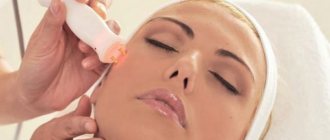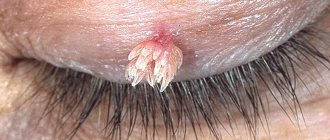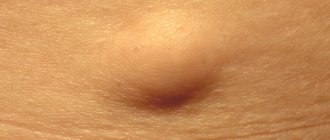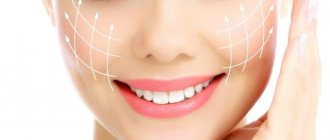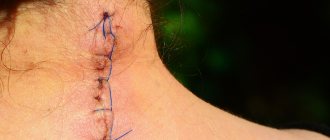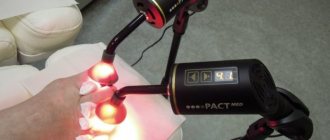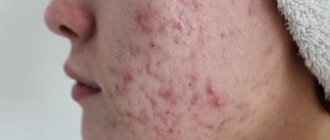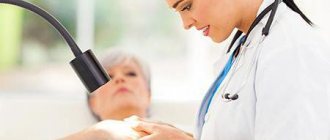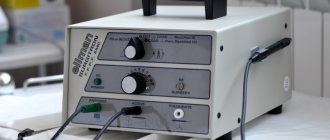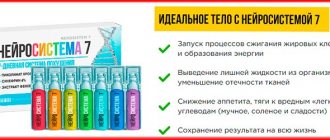Even a small flaw in the skin can ruin a woman’s mood, especially when it comes to scars and scars. Such unaesthetic marks can appear as a result of any injury to the skin - a burn, a cut, surgery, or even a pimple. Fortunately, science does not stand still and today there are technologies that seem to erase ugly prints from the skin.
Laser is considered one of the most effective and popular methods of getting rid of scars (find the 5 most popular laser procedures here). BeautyHack has figured out this issue and is ready to share all the pros and cons of the procedure.
Features of the laser scar resurfacing method
It is impossible to completely remove imperfections on the skin , but thanks to laser resurfacing, and then the use of special medicinal products that restore the skin, they become almost invisible.
Human skin is formed from 3 layers: subcutaneous fat, dermis, epidermis. In case of damage to the dermis, the human body quickly responds to the impact and covers the wound with a lump of blood. The body's cells then produce collagen, which forms scar tissue.
The procedure for resurfacing scars with a laser allows you to quickly remove the defect and even out the surface and color of the affected area. The results before and after surgery are amazing!
To understand how laser resurfacing works, you need to know the characteristics and types of scars.
There are these types of scars:
- Normotrophic;
- Atrophic;
- Keloids;
- Tightened;
- Hypertrophic;
- Stretch marks (striae).
The result of laser scar resurfacing before and after the procedure depends on the type, area and depth of skin damage.
Laser removal of scars and scars is done using 2 methods - erbium and neodymium lasers:
- Erbium laser produces classic grinding. Helps improve skin and remove blemishes. It destroys the top layer of the skin using a beam of light. The laser beam evaporates moisture from the tissue layer, due to which a new layer of skin is formed, cell regeneration starts, and blood circulation improves.
- Neodymium laser is one of the safest means for getting rid of scars. It is almost impossible to get a burn from it. The laser penetrates the skin 2 mm, and grinding is done pointwise. The main feature is that it affects diseased cells, but does not affect healthy ones. Removes scars of various origins.
Laser scar correction technologies
Scars differ in color, width, and severity, so different laser systems are required to remove them. You may be offered to remove scars with one of the following devices:
Erbium
Erbium laser scar removal is nothing more than laser resurfacing, a procedure during which the surface (skin layers) are evaporated.
The wavelength of the ER:YAG laser is 2940 nm, which coincides with the maximum of the absorption spectrum of water, which means that when exposed to a laser pulse on water-containing tissue, water is quickly converted into steam. Due to the abrupt pressure drop, fragments of biological tissue leave the laser impact area and the scar gradually smoothes out.
The main advantages of the erbium laser are the absence of demarcation lines between treated and untreated areas, as well as minimal tissue burns and the possibility of use in patients with very dry skin. If we talk about the rehabilitation period, then compared to a carbon dioxide laser it is 2 times shorter.
The erbium laser shows high effectiveness in removing postoperative scars and scars that have arisen after acne.
Carbon dioxide (carbon dioxide)
If an erbium laser is considered gentle, then a carbon dioxide laser is considered aggressive. It was one of the first to be used for the treatment and removal of scars of various etiologies, but today it is used in exceptional cases and mainly to eliminate scars in patients with deep scars on oily skin. This laser is also ablative, i.e. the effect is achieved through evaporation and triggering the process of collagen production.
Removing scars with a carbon dioxide laser is a painful procedure, so it is preceded by the application or administration of anesthesia. After this, the laser, by direct action on the skin, removes layer by layer of microlayers of the skin. The recovery period takes 3-6 months (depending on the size and depth of the scar).
Fractional
These are the latest generation lasers, and today they are recognized as the most effective in terms of skin rejuvenation and elimination of defects.
Fractional laser creates thousands of microscopic holes in the surface of the skin. The skin around these holes is not injured. The skin reacts to the procedure with increased collagen production and rapid healing. Thus, several sessions of exposure to a fractional laser, and the scarred skin will be replaced by a new, absolutely healthy and smooth one.
Thanks to this unique technology, the recovery period is minimal. If scars on the body were removed by laser, then the very next day you can return to your usual pace of life. If the laser affected the scar on the face, then you will have to sit at home for 3-4 days.
Pulsed dye laser
The pulsed laser copes well with newly formed scars, those that are red in color or tint. Its impact causes disruption of blood flow, which, in turn, leads to a cessation of nutrients and collagen production. Scars, even keloid ones, after treatment with a pulsed laser lose color, become softer and hypertrophic. Several sessions significantly relieve itching and reduce the size of the scar.
Neodymium
Neodymium laser is non-ablative, i.e. It is not able to damage the skin of the scar. It only penetrates inside and affects the internal structures of scar tissue. So, if it is necessary to remove a keloid scar, it is exposed to an ultra-long pulse. The result of this effect is the cessation of collagen production, so after a certain period of time the scar begins to decrease in size, and in some cases disappears altogether.
Atrophic scars are removed somewhat differently. Visually, such scars are somewhat recessed into the skin, and for them to disappear, intensive filling of the scar with collagen is required. The laser initiates this process. The result is a smoothing of the scar and an increase in its elasticity.
Consider other popular treatments such as blackhead removal.
Indications and contraindications for the procedure
Indications and contraindications are determined by a specialist individually for each patient.
Indications:
- Uneven skin texture;
- Enlarged pores;
- Acne scars;
- Shallow wrinkles;
- Freckles;
- Dark spots;
- Loose skin;
- Post-operative spots.
Laser resurfacing of age spots - before and after the procedure.
Contraindications:
- Skin inflammation;
- Psoriasis;
- Severe form of diabetes mellitus;
- Allergy;
- Eczema;
- Oncological skin diseases;
- Pregnancy.
How scars form
After damage to the follicle, hairs do not grow over the entire surface of the damaged area of the body. Most skin defects cause complexes that are difficult to deal with. In other cases, they cause discomfort.
They are all different from each other. Depending on the severity of the injury, the location of the injury and other factors, they are divided into several types:
- normotrophic scars (by external signs, pale pink, easily stretched);
- hypertrophic scars (have a purple or bluish color, rise on the skin, consist mainly of fibrous connective tissue. As a result of such damage, in some cases, the mobility of the affected part of the body is impaired);
- atrophic scars (the skin retracts, the damage is caused by acne or stretch marks);
- colloidal scars (similar to hypertrophic scars, but different in structure, and in most cases a relapse occurs).
In the recent past, scar removal was something fantastic. Today plastic surgery can easily cope with this problem.
Possible side effects and negative consequences
Side effects of this procedure are few, but they do exist.
Here is their list:
- Erythema . Erythema may occur 2 weeks after the procedure. It goes away in 3-4 months. This response of the body is explained by the individual inflammatory reaction of the skin or the immaturity of the new epithelium.
- Pigmentation disorders. Pigmentation disorders can be of 2 types: hyperpigmentation, hypopigmentation. Hyperpigmentation often occurs in people with dark skin tones. Hypopigmentation is considered a sign of local death of melanocytes.
- Scarring . The most serious complications are scars. The risk of occurrence depends on the power of the radiation energy, the number of passes and the positivity of the pulse.
- Infectious complications. Infectious complications are unlikely, but possible. When sanding the skin, the tool does not touch the skin, and the thermal effect cleanses the skin. However, an infection that was previously sitting deep in the pores may appear.
Comparison of scars that can and cannot be treated with laser correction.
It is important to know! Sometimes, when resurfacing scars with a laser, other side effects are observed: milia or acne. To minimize the risk of their occurrence, you need to follow the recommendations of specialists both before and after surgery.
Risks and side effects of laser scar removal
Each type of laser treatment has some side effects:
- The patient may feel a little discomfort after the procedure;
- In most cases, redness, itching or swelling appears in the first hours after treatment;
- Increased sensitivity to the sun;
- Sometimes a change in skin pigmentation occurs (lightening of the site of the removed scar);
- Inflammation may develop as a result of improper care after surgery.
Some degree of scarring may persist after treatment, and even several sessions of therapy may not completely eliminate large scars.
How does the laser scar resurfacing procedure work step by step?
Laser scar resurfacing is carried out using various methods, but any procedure is divided into a number of stages. First, the skin area is anesthetized with a special agent , which is planned to be treated with a laser. If the procedure will be performed on the patient's face, anesthesia is administered and protective glasses are placed over the eyes.
Laser scar resurfacing lasts no more than 1 hour.
In the photographs before and after the procedure, you can see how much the skin changes due to the influence of the device. During this process, a slight burning sensation may be felt, which persists for some period of time even after the procedure is completed.
Laser scar resurfacing procedure.
Redness and swelling may appear, and a crust appears at the site of the scar, which lasts for about 7 days. The recovery process lasts about a week. This is the time to apply gauze bandages with antibacterial ointments. Before going outside, you need to apply sunscreen to your face.
Important! If the scars are deep, then an additional course of procedures is performed.
Dermabrasion or laser resurfacing
This type of skin correction is the safest and most painless, because the effect on individual areas of the face or body occurs without contact, which minimizes the recovery period and also prevents the occurrence of any complications. This procedure is also called deep facial peeling, since the laser acts on the upper layers of the epidermis, renewing them, removing fine wrinkles and improving skin color.
Despite the fact that in the process of dermabrasion only intervention occurs in the outer layers of the skin, with the help of laser resurfacing of scars you can get rid of post-acne, permanent makeup and tattoos, enlarged pores, age spots, and also rejuvenate the skin of the face.
On average, the effect occurs after 5-7 procedures, however, in difficult cases, a specialist may prescribe additional sessions for you.
Is laser skin resurfacing painful?
To protect the patient from pain, the patient is given general anesthesia before performing the procedure. If the procedure is performed on a specific part of the face, local anesthesia is used.
If the scar area is small, then there may not be any particular pain even in the absence of anesthesia.
When the entire face is exposed, painkillers are used. For a long time after the end of the operation, warmth is felt under the skin. It can be either weak or strong. If the pain is unbearable, the patient is prescribed painkillers.
A bandage containing anesthetic gel or ointment is usually applied.
Scar treatment
Laser treatment of scars (resurfacing) is most often used to treat hypo-, normo- and hypertrophic facial scars. An ablative laser (CO2, erbium) creates an “ideal wound” with smooth edges and a smooth surface, creating favorable conditions for healing. The skin at the site of grinding is leveled, and a skin structure close to natural is recreated. Depending on the number (single or multiple scars), as well as their severity, total or fractional resurfacing can be used.
In some cases, other types of treatment are used:
- Injections of anti-scar drugs into the scar. First of all - diprospan. It is actively used for hypertrophic and keloid scars and has significant effectiveness. In 2-3 injections (performed once a month) it allows you to even out significantly raised and old scars;
- Contour plastic surgery – used to treat hypotrophic (retracted) scars;
- The use of ointments, silicone sheets and coatings – are more often used to prevent the occurrence of hypertrophic and keloid scars;
- Surgical excision is effective for treating large, deforming scars. And also in case of violation of the technique of suturing the primary wound (incorrect comparison of edges, uneven edges, wound suppuration).
Rehabilitation after the procedure, healing period
Rehabilitation takes a long time. If you follow the rules, you can avoid complications and possible negative effects. During the first week, you need to completely stop using cosmetics and stop washing your face with cosmetics.
Sunbathing is prohibited, and for some time before each exit, it is recommended to smear your face with sunscreen with a medium or high degree of protection against sunlight. If the sun's rays hit unprotected areas of the skin, hyperpigmentation may occur.
During the first week, on the area of skin that was treated you can observe:
- Peeling;
- blisters;
- Crust;
- Redness.
After laser resurfacing of scars, healing and restorative agents can be used.
There are special preparations for this – “Dermaheal post lazer cream”, for example. It is important to know! Laser resurfacing of scars increases the sensitivity of the skin, which may cause pain after the procedure. If the pain is severe, the doctor prescribes painkillers. This can be done both before and after surgery.
Removing scars with liquid nitrogen
After liquid nitrogen (its temperature is -190 degrees) hits the damaged area of the skin, the dead cells freeze. The cold penetrates so deeply that oxygen no longer reaches the scar or scar. Without receiving recharge, frozen biological membranes are destroyed. A dead zone, the necrosis zone, forms around the scar and scar. Then, within a few weeks, tissue macrophages destroy the connective tissue and the scar disappears forever.
However, the procedure has several possible complications. Most often, after direct exposure to cold nitrogen, there is a small blister or blisters in the treated area. Sometimes the patient experiences pain. But this is a normal reaction that does not require medication to eliminate. If, after cryodestruction of scars, swelling, severe redness appears, or an increase in temperature is felt, then this is a reason to consult a doctor.
Removing nitrogen scars forces the patient to observe safety measures during the recovery period:
● do not get wet, do not go to the bathhouse, sauna;
● protect from exposure to direct sunlight;
● do not mask the scar with cosmetics;
● do not peel off the crust yourself, wait until the dead cells separate on their own.
When the result of grinding is visible
Patients of the laser resurfacing procedure for scars and scars say with confidence that it is progressive. The first noticeable results of the resurfacing are visible 2-3 weeks after the first operation.
The result of laser scar resurfacing - before and after the procedure.
More noticeable results are visible after 2-6 months. The effect appears after a full course of laser resurfacing. Pigment spots, acne marks, scars and scars become less noticeable. The skin changes and becomes smoother and more elastic.
The result of laser polishing lasts for a long time – up to several years. After this period has expired, you can repeat the procedure.
Treatment of keloid scars in our center
The State Scientific Center for Laser Medicine provides comprehensive treatment of keloid scars to achieve maximum therapeutic effect. A course of restorative procedures is prescribed after making a diagnosis and studying the patient’s medical history.
Surgical removal of a keloid is ineffective; moreover, mechanical damage to the tissue stimulates collagen growth and promotes re-growth of the scar.
Today it is possible to get rid of scars using progressive methods. The colloidal scar, which takes 6–12 months to heal, is treated with a laser. Come to our center, and experienced specialists will help you get rid of scars using modern equipment using the latest technologies and medications without relapse. Treatment of keloid scars with laser in combination with the administration of corticosteroid drugs gives very good results.
When should laser scar resurfacing be performed?
The number of necessary procedures is determined by a specialist . To do this, the condition of the skin, the depth of scars and scars are assessed. The outcome of laser resurfacing is noticeable after the first procedure.
If they suit the patient, then there is no need to carry out a whole course of laser treatment. Specialists carry out a repeated procedure if necessary. It is allowed to do this no earlier than after 2-3 months. Anti-aging skin resurfacing is allowed to be done no more than 1-2 times a year.
The result of several laser resurfacing procedures for deep scars - before and after.
This will be quite enough to achieve the result of getting rid of any types of wrinkles. also be carried out as a preventive measure , but in a simplified form.
This way the skin will remain fresh and healthy looking.
How is the procedure performed?
The procedure is always performed on an outpatient basis, under the supervision of a cosmetologist or doctor. As preparation, it is recommended to give up all alcohol and nicotine a week before the session.
Since cryotherapy for scars is painless, there is no need to apply painkillers to the skin before starting treatment. Nitrogen is applied immediately. There are two ways to apply it:
● using tampons. It is immersed in coolant and pressed against the rumen. It is important to choose the correct tampon size. The larger one will absorb more nitrogen, which means the skin will “receive” a larger dose. However, if too much of the substance gets on the body, it can freeze not only the dead scar, but also living, healthy tissue;
● using special devices - aerosols with a tip. Through it, the cosmetologist sprays nitrogen onto the skin. The degree of freezing (and therefore efficiency) depends on the size of the nozzle, the location of the device relative to the body, the pressure in it and the duration of nitrogen treatment;
● using probes. If the scar has an elongated straight shape, then it is difficult to apply the right amount of coolant and it is difficult not to damage healthy skin. Therefore, it is optimal to use a probe that matches the size of the scar. It is cooled in nitrogen and then applied to the scar. The only difficulty with this method of application is the selection of a probe if the length or width of the scar is non-standard.
As a rule, during one procedure, the scar is treated 2-3 times, each time holding the substance on the skin for 10-30 seconds.
After the procedure, a small bubble first forms at the site of the scar, and then the dead skin turns into a crust. Within 3-4 weeks, this crust separates from the healthy skin. Since the scar is frozen from the root, there are no traces left in its place.
Where is laser resurfacing of scars and cicatrices performed? Cost of the procedure
Prices for laser resurfacing of scars and scars are individual and depend on many factors. It depends on the area of the area that is planned to be processed. The degree of problem of the skin matters.
The cost of laser scar resurfacing procedures can vary widely. As are the results before and after treatment. It may largely depend on the region in which it is carried out. And also from the clinic where laser resurfacing is performed.
For example, prices in Moscow may differ from prices in Yekaterinburg. The price varies from 5,000 rub. up to 60,000 rub. All conditions for the upcoming operation are discussed face-to-face with the administration of the clinic to which the person decided to go.
Operating room and equipment for laser scar resurfacing.
If the patient wants to make their skin healthier and more attractive, laser scar resurfacing is an option, showing the difference before and after. It does not cause severe discomfort after the procedure; in rare cases, it causes pain during surgery. The procedure is 100% safe , because only professional specialists using specialized equipment are allowed to carry it out.
Reviews
A year ago I had surgery, which left a scar on my stomach. It was especially noticeable in the summer, when the rest of the skin was tanned. Before the summer season I had laser resurfacing of the scar. I am very pleased with the result. All marks were completely gone within a month after sanding. I hope that the skin will now tan evenly too. I recommend doing such procedures not in beauty salons, but in clinics. There are professionals on a completely different level, not just cosmetologists. I am very pleased with the llama.
Olga (Moscow, March 2014)
I went to the clinic to resurface a scar on my arm after a car accident. The scar is about 5 cm on the inner surface of the arm. I couldn't wear short sleeves in the summer as it looked terrible. For a long time I didn’t dare to start removing it, but a friend advised me to do laser resurfacing. Now after three procedures the scar is practically invisible. She refused anesthesia for the operation herself. It was unpleasant, but not terrible. But then everything passed quickly. After three weeks the wound healed. I recommend the surgeon Mitish E.V.
Valentina (Moscow, 2013)
“After a difficult case of peritonitis, from which all the hospital doctors saved me, I was left with three huge scars all over my stomach, which I really wanted to get rid of. I searched for a clinic for a long time and accidentally found out about Lama. After conducting a consultation, Evgeniy Nikolaevich Burkun promised to help me and fulfilled his promise. A year after surgery, I can wear a swimsuit without embarrassment because my scars are practically invisible. I also want to thank the clinic staff, who take great care of the patients, and recommend Lama.
Alexandra (Moscow, 2020)
I had a scar on my cheek resurfaced after an injury at the clinic. In summer, the scar looked very unaesthetic and was very different in color from tanned skin. Three sandings were enough to leave almost no mark. Now I'm waiting for summer to see how different the area under the scar will be on tanned skin. The surgeon said that it would be practically invisible. The impression is great!
Sergey (Moscow Region, Naro-Fominsk, 2014)
Last year I burned my hand. She was very careful with the burn while the wound healed, but a scar still remained. I went to the clinic for laser scar resurfacing. I had three operations between each of which there was a month. By the third time the scar was no longer visible at all. I was very afraid that it wouldn’t work out, but everything turned out great. Thank you very much to surgeon Mitish. E.V. I'm very glad that everything worked out.
Alexandra (Moscow, 2014)
About 10 years ago I burned my hand while repairing a car on a manifold, and then picked off the sore. So the scar on my hand remained for all these years, until I decided to finally remove it. I had a burn scar resurfaced with a laser at the Lama clinic with surgeon Elena Valerievna. I was very pleased with both the result and the clinic. The atmosphere is cozy, there are no queues, everything is by appointment. Convenient and inexpensive.
Leonid (Moscow, August 2013)
I had an old burn on my leg the size of a 5 ruble coin. I decided to remove it before the summer season. I spent a long time choosing a method and decided to do laser resurfacing at the Lama clinic. Honestly, I'm very pleased. The clinic is very good, everything is clean. Friendly staff. The price list was exactly what it was. After two procedures, there was practically no trace left of the scar. It was done under local anesthesia. It didn’t hurt at all, and then it didn’t hurt very much. I recommend everyone not to hesitate, but to do laser surgery.
Victoria (Moscow, 2013)
“Ten years ago, a terrible event happened: glass from a broken window left noticeable scars on my face. It was very scary to decide to have an operation - what if it gets even worse? So I suffered for so many years... Maybe I still would, if my friend had not literally led me by the hand to “Lama” to Nikeshin Akim Yosifovich. He is not just a wonderful person, but a great specialist, as is everyone else in this clinic. This is how I received a “new face” and help that I had never even dreamed of. Thanks everyone."
Alena (Balashikha, 2020)
I would like to express my gratitude to Dr. Evgeniy Nikolaevich Burkun! I contacted him about laser resurfacing of a scar on my leg. The doctor told me everything about the procedure and warned that in my case it would take several sessions for the scar to be completely invisible. In total, I had to do the polishing in three sessions, but each time it was short-lived and without any unpleasant sensations. Now I am completely satisfied with the result, there is normal smooth skin at the site of the large scar.
Svetlana (Moscow 2017)
I was resurfacing a scar on my arm that was left after an accident when I had surgery. For two years I thought that it would resolve itself, but it didn’t happen. It brightened, but did not become smaller. The view was so-so. The surgeon removed it with a laser in one go. It wasn’t even worth waiting that long, but should have done it right away.
Alexander (Aprelevka, December 2013)
In the office kitchen, I poured hot soup on my foot when I took it out of the microwave. The burn was 10 square centimeters. It didn’t heal for a long time, and then a scar remained on my leg. So she had it removed at the clinic. I had laser resurfacing of the scar under local anesthesia. It didn't hurt. The leg became straight, without bumps. It is still visible that the skin is a different color, but I hope that by summer everything will pass. I liked the clinic. The attitude of the staff and doctors is very good. There is a positive atmosphere in the clinic.
Kristina (Moscow, April 2014)
Articles on the topic
Face resurfacing for scars
Beautiful, clean and healthy skin is the dream of not only women, but also representatives of the stronger half of humanity. But what should those whose skin has imperfections, such as scars, scars or acne spots, do? Modern cosmetology offers many options […]

